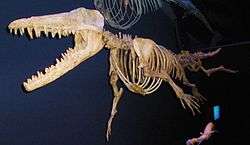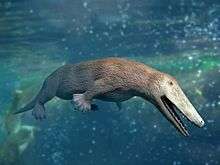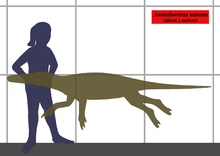Ambulocetus
| Ambulocetus | |
|---|---|
 | |
| Skeleton | |
| Scientific classification | |
| Kingdom: | Animalia |
| Phylum: | Chordata |
| Class: | Mammalia |
| Order: | Artiodactyla |
| Infraorder: | Cetacea |
| Family: | †Ambulocetidae |
| Genus: | †Ambulocetus Thewissen et al., 1994 |
| Species: | †A. natans |
| Binomial name | |
| Ambulocetus natans Thewissen et al., 1994 | |
Ambulocetus (meaning "walking whale") is an early cetacean from Pakistan. It is named as such because it had short limbs and large feet used for swimming. Along with other members of Ambulocetidae, it is a transitional fossil that shows how whales evolved from land-living mammals. While its name stems from the historical hypothesis that it was capable of walking on land, more recent research suggests that it was fully aquatic like modern cetaceans.[1]
Description

Ambulocetus was probably fully aquatic like modern cetaceans, with a similar thoracic morphology, and it probably swam by undulating its back vertically.[1] Chemical analysis of its teeth shows that it could move between salt and fresh water. It also lacked external ears. Its skull had a long snout and eyes facing sideways (they faced upward in pakicetids), located high on the skull like in modern hippos.[2]
Several features shared with other basal cetaceans indicate the close affinities of Ambulocetus with these animals; it had an adaptation in the nose that enabled it to swallow underwater, and its periotic bone's structure was like those of whales, enabling it to hear well underwater. In addition, its teeth are similar to those of other early cetaceans. [3]
Ambulocetus had a feeding morphology similar to that of crocodiles: a long snout, pointed teeth, and strong jaw adductor muscles. Like crocodilians, Ambulocetus probably killed its prey by holding it in its jaw and either drowning it or thrashing it with violent motions. Similar to larger crocodilians, adult Ambulocetus probably were ambush predators that fed on larger fish, aquatic tetrapods and possibly terrestrial animals near the water. In contrast to crocodilians, it may have chewed its prey but probably did minimal food processing with its teeth.[3]
The short forelimbs of Ambulocetus had five fingers on each hand and its long hindlimbs had four toes on each foot. It had dense osteosclerotic limb bones, suggesting it was well-adapted for living in water but moved slowly, probably hunting as an ambush predator. Its pelvis was attached to its spine, like land mammals and unlike later whales.[4] Its powerful tail, which lacked a tail fluke,[4] was apparently used for locomotion, and it probably moved similar to a modern river otter. Pakicetids and ambulocetids used their large feet and hind limbs for propulsion; morphologically, the thigh and leg of Ambulocetus were shortened, but the feet stayed large; this resulted in a reduction in lever arm but a retention of a large propulsive surface, indicating that the hind limb functioned as an oar. In later Eocene cetaceans, such as the basilosaurids and remingtonocetids, the tail gained a fluke and became the dominating source of propulsion, while the leg became more reduced and rudimentary.[5]
Size

Ambulocetus was the size of a male sea lion, much larger than Pakicetus. Thewissen et al. estimated the body weight of Ambulocetus at 141–235 kg (311–518 lb),[3] while Philip D. Gingerich estimated it at 720 kg (1,590 lb).[6]
Discovery
Ambulocetus was recovered from the Early Eocene (47.8-41.3 Ma) Kuldana Formation of Punjab, Pakistan (33°36′N 72°12′E / 33.6°N 72.2°E, paleocoordinates 14°18′N 68°18′E / 14.3°N 68.3°E)[7] in 1993 by Johannes G.M. Thewissen and Sayed Taseer Hussain, and was described by Thewissen, Hussain, and Mohammad Arif in 1994.[8] It is believed to be from the Lutetian age of the Paleogene period (48.6 to 40.4 million years ago).[9]
Fewer than ten ambulocetid fossils have been found, all in shallow sea or coastal swamp environments. Ambulocetus is the only virtually complete skeleton known from the group. At the time when the animal was alive during the Eocene, the length of Pakistan was a coastal region of Eurasia, as India had not yet collided with Asia.
Classification
Ambulocetus is classified under the monophyletic family Ambulocetidae. The family is believed to have diverged from the more terrestrial Pakicetidae. The families Protocetidae and possibly Remingtonocetidae, are believed to have arisen from a common ancestor with ambulocetids.[10] Together with Basilosauridae, the five families are classified under the suborder Archaeoceti.[11]
See also
References
- 1 2 Ando, K.; Fujiwara, S.-I. (2016). "Farewell to life on land – thoracic strength as a new indicator to determine paleoecology in secondary aquatic mammals". Journal of Anatomy. 229 (6): 768–777. doi:10.1111/joa.12518. PMID 27396988.
- ↑ Thewissen, J. G. M.; Cooper, Lisa Noelle; George, John C.; Bajpai, Sunil (2009). "From Land to Water: the Origin of Whales, Dolphins, and Porpoises" (PDF). Evolution: Education and Outreach. 2 (2): 272–288. doi:10.1007/s12052-009-0135-2.
- 1 2 3 Thewissen, J. G. M.; Madar, S.I.; Hussain, S.T. (1996). "Ambulocetus natans, an Eocene cetacean (Mammalia) from Pakistan" (PDF). Courier Forschungsinstitut Senckenberg. 191: 1–86. ISBN 9783929907322. OCLC 36463214.
- 1 2 Kemp, T. S. (2005). The Origin and Evolution of Mammals (PDF). Oxford University Press. ISBN 0-19-850760-7. OCLC 232311794.
- ↑ Thewissen, J. G. M.; Cohn, M. J.; Stevens, L. S.; Bajpai, S.; Heyning, J.; Horton, W. E. (2006). "Developmental basis for hind-limb loss in dolphins and origin of the cetacean bodyplan" (PDF). PNAS. 103 (22): 8414–8418. doi:10.1073/pnas.0602920103. PMC 1482506. PMID 16717186.
- ↑ Thewissen, J. G. M. (2013). "Cetacean Origins: Evolutionary Turmoil during the Invasion of the Oceans". In Thewissen, J. G. M. The Emergence of Whales: Evolutionary Patterns in the Origin of Cetacea. Springer. pp. 451–460. ISBN 9781489901590.
- ↑ "H-GSP 9210 (Eocene of Pakistan)". Paleobiology Database. 2005.
- ↑ Thewissen, J. G. M.; Hussain, S. T.; Arif, M. (1994). "Fossil evidence for the origin of aquatic locomotion in archaeocete whales". Science. 263 (5144): 210–212. doi:10.1126/science.263.5144.210. PMID 17839179.
- ↑ 'Ambulocetus' in the Paleobiology Database. Retrieved September, 2013
- ↑ Uhen, M. D. (1998). "Phylogenetic relationships of Basilosaurids". In Thewissen, J. G. M. The Emergence of Whales: Evolutionary Patterns in the Origin of Cetacea. Springer. p. 43. ISBN 978-0-306-45853-8.
- ↑ Rose, K. D. (2006). The Beginning of the Age of Mammals. JHU Press. ISBN 978-0-8018-8472-6.
External links
- "Ambulocetus". BBC Nature.
- "Whale Origins". Thewissen Laboratory.